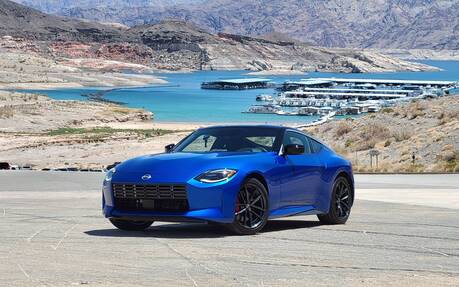2023 Nissan Z : Like Reconnecting With An Old Friend
Nissan was once recognized as a performance-oriented brand until it kicked almost all of its sports cars to the curb (with the exceptions of the 370Z and the unattainable GT-R) and replaced them with sad-looking SUVs equipped with continuously variable transmissions.
For someone who grew up during Nissan's glory years, this was like seeing an old friend lose their joie de vivre. Fortunately, the Japanese manufacturer is kicking things back into gear by introducing the new 2023 Nissan Z, starting at $46,498.
- Also: The New 2023 Nissan Ariya and Nissan Z Uncovered at Nissan Studio in Toronto
- Also: Nissan May Have Regrets About the New Z’s Front Grille
The Car Guide flew to Nevada to take part in the media launch of the 2023 Z, which Nissan has entrusted with the heavy task of re-bonding with performance enthusiasts.
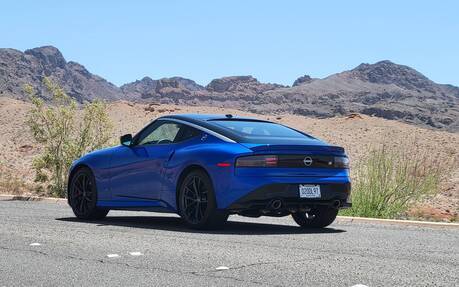
Infiniti Performance
Performance is no guarantee of success for an affordable sports car. With that said, Nissan, whose powertrain lineup isn't as resplendent as it once was, has dusted off its best workhorse to power the Z. Namely, the twin-turbocharged 3.0-liter V6, which also powers the Infiniti Q60 Red Sport. This unit outputs 400 horsepower and 350 lb-ft of torque.
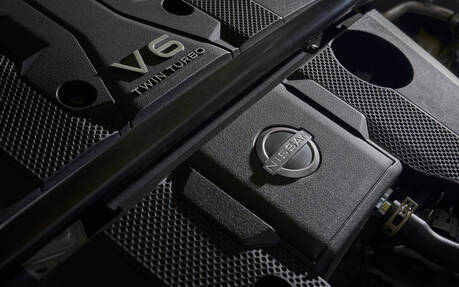
Changes have been made to key components of this powertrain before it was bolted under the hood of the new Z. For example, the turbochargers are now equipped with a recirculation valve that helps build pressure faster, while keeping the turbocharger at a constant speed when you take your foot off the gas. This translates into quicker acceleration and faster pickups on the highway.
A choice of two transmissions is on the menu: a standard six-speed manual fitted with an EXEDY clutch and a brand new nine-speed automatic.

The Modified 370Z Chassis (Same Same, But Different)
Designing a chassis from scratch is an expensive process, especially if it can't be adapted to other models (electrified, for example). Therefore, engineers took the chassis of the now-defunct 370Z and made various iterations. As a result, the chassis gained in torsional rigidity and the front section was lengthened to accommodate the piping and various coolers needed for the turbocharging system.
For comparison, the base 370Z with the manual transmission weighed 3,333 pounds. The base Z with the same manual transmission tips the scales at 3,486 pounds. That's 153 pounds more. Meanwhile, the weight distribution remains the same: 55% front and 45% rear.

Judicious Compromises
On the pristine Nevada desert roads that served up a variety of turns and straights, the Z's handling surprised us in its ability to blend ride comfort and agility. Not only does the engine make ample power to devour the pavement ahead, the throttle response is surprisingly satisfying. In addition, the six-speed manual transmission makes everything more fun. All that's missing is a more assertive exhaust note, which we found too muffled.
The electronically assisted steering system is nicely weighted and feels precise. This is refreshing for this type of system, which often feels disconnected from the road.
The Z is also geared with a competent braking system to tame the driver’s ambitions and handle the coupe’s weight.
We were also invited to participate in track activities at the Las Vegas Motor Speedway. This was an important exercise considering the Z's reputation and its target buyer's love of spirited driving. While the 400 ponies all showed up at every straight, the suspension could have benefited from more stiffness. It was too soft on corners compared to some rivals. There’s room for improvement here. Maybe Nismo should look into it!

A Simple Cockpit with a Mix of New and Old
The new Nissan Z looks small from outside—too small for tall drivers. However, this is not the case, as the driving position and visibility are generally good and there’s plenty of clearance for a helmet.
Nissan's intuitive infotainment system sits in the middle of the dashboard and is paired with analogue controls. The screen measures only eight inches for both variants of the Z. It's ergonomic enough overall, except for the ventilation controls hidden in the lower section.
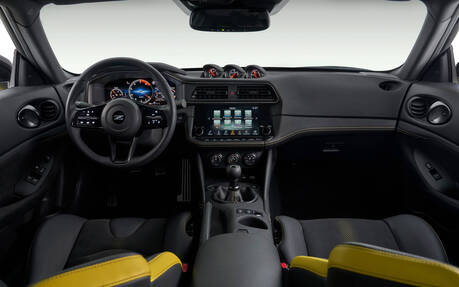
To pay homage to its ancestors, the new Z sports a trio of gauges in the upper part of the dashboard. Unlike the 12.3-inch instrument cluster behind the steering wheel, which is fully digital, these dials are analogue and display turbocharger pressure, turbocharger speed, and battery voltage. In lieu of the last two, we would have preferred more useful oil pressure and coolant temperature gauges. But that’s a small detail.
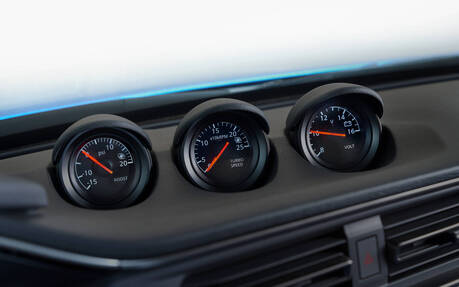
The Final Word
The Z doesn’t sit on a new platform, it doesn’t have an electrified powertrain, and it makes slight compromises here and there to keep the accountants happy. However, it’s clear that no corners have been cut, either in terms of design or engineering, and the Z is qualified to provide chills and butterflies on the road. In the grander scheme of things, this model shows that Nissan hasn't forgotten that there are still people out there who like to drive.
| Test drive report | |
| Test model | 2023 Nissan Z |
|---|---|
| Trim level | Sport |
| Price range | $50,000 – $55,000 |
| Price as tested | CA$50,000 |
| Warranty (basic) | 3 years/60,000 km |
| Warranty (powertrain) | 5 years/100,000 km |
| Fuel economy (city/highway/observed) | N/A |
| Options | N/A |
| Competitive models | Chevrolet Camaro, Dodge Challenger, Ford Mustang, Subaru BRZ, Toyota GR86, Toyota GR Supra |
| Strong points |
|
| Weak points |
|
| Editor's rating | |
| Fuel economy | N/A Not evaluated |
| Comfort | Comfortable seating for the driver and passenger. |
| Performance | Great performance from the twin-turbo V6. |
| Infotainment | Small screen, but easy-to-use controls. |
| Driving | Great driving dynamics on the road. A little soft on the track. |
| Overall | The new pays pays proper tribute to its ancestors |
